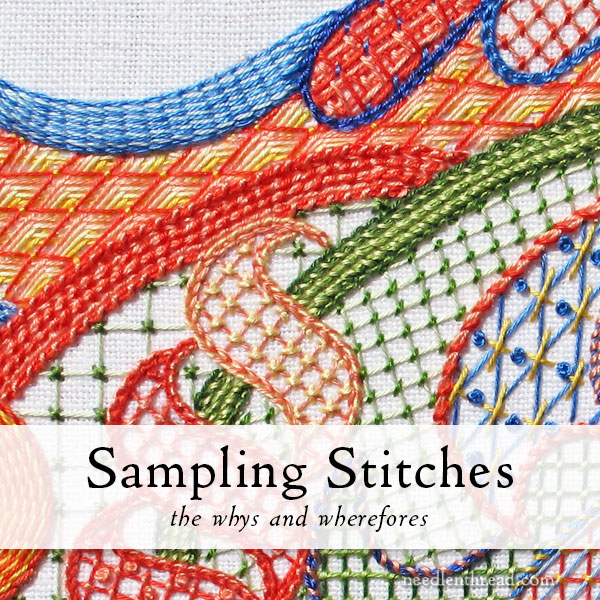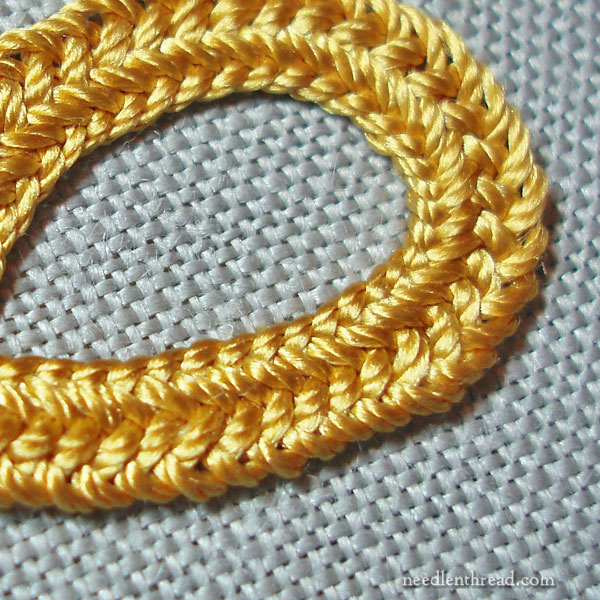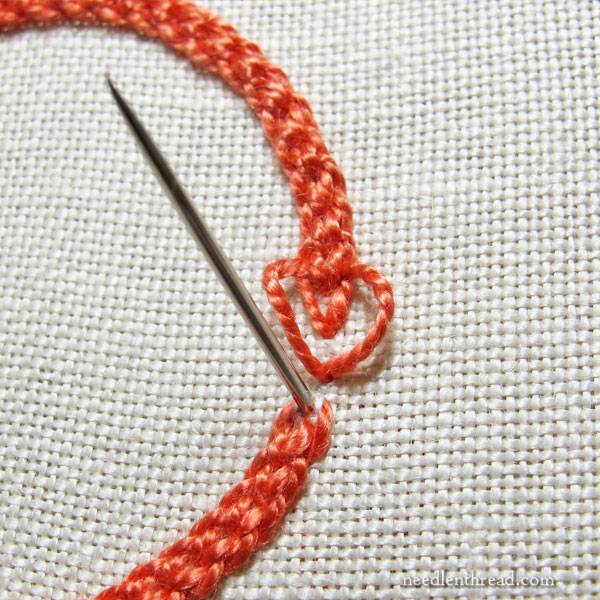Oh! I had a big surprise earlier this week in response to Wednesday’s article – Where Did the Blogs Go? – at the end of which I asked if you had any topic suggestions or anything specific you wanted to learn regarding embroidery.
It worked out well, because I already had today’s article somewhat in the works, as a continuation of the “revisiting” series that I started earlier this summer. In that short series, we revisited topics or projects that I’ve covered in the past here on Needle ‘n Thread.
I received a lot of feedback on Wednesday’s blog post, and many good suggestions for embroidery topics to visit – or visit again – here on the website.
A repeated request had to do with learning stitches. And I realized that a lot of time has gone by since we chatted about one of my pet embroidery topics …

….. which is sampling embroidery stitches.
I was surprised – and rather delighted – at how many people wrote in asking about stitches – learning different stitches, troubleshooting particular stitches, working samplers of stitches, and similar topics that had to do with the Embroidery Stitch.
There’s nothing more fun to me (embroidery-wise) than playing around with embroidery stitches! I find it sooooo very satisfactory to fiddle about with stitches – learning a new stitching, creating a composite stitch, figuring out how to manipulate a stitch around a corner or a curve, testing the variations of a stitch, troubleshooting different aspects of a stitch… I just love to fiddle with stitches!
I think that fiddling with stitches – sampling stitches – is a great way to learn! But not just to learn one particular stitch. No, no! When you play with stitches, you learn all about embroidery. You learn how the thread and the fabric work together. You learn why to use this needle or that. You learn how to read a diagram. You learn how to try new things without fear. You learn how to test theories. You learn what works and what doesn’t and why. You learn how to make corrections. You learn how to be confident with your needle and thread.
All of these aspects of learning while stitching are super important if you want to grow and excel along your embroidery journey.
This isn’t to say you have to know every stitch under the sun. Gosh no! You can be an excellent embroiderer if you only know one stitch well. Or two. Or ten. Or two hundred!
But it is helpful to learn some stitches quite well (I recommend starting with these ten embroidery stitches), and it is helpful to really explore embroidery stitches now and then, if you want to become really comfortable and confident with stitching.

We’ve done a whole lot of stitch sampling here on Needle ‘n Thread! You’ll find many articles on working samplers and doodle cloths. You’ll find many step-by-step instructions for different stitches, stitch combinations, composites, techniques… all things that you can play with and expand on, to learn what you want to learn.
If you’re new to Needle ‘n Thread, you may not have seen these articles in the archives. If you’ve been around for a while, you may have forgotten that they’re there!
Further Reading on Sampling & Stitches
And so, without further ado, here’s a short list of articles and indexes that will help you with sampling stitches. They will encourage you to start your own learning samplers, to use doodle cloths, and hopefully to play around a bit with embroidery stitches.
On Stitches and Samplers and Such
More On Embroidery Stitches & Samplers
The Stitch Sampler vs the Doodle Cloth
A Circle Sampler: Stitching Embroidered Spots
Stitch Fun Index – heaps of photo tutorials for all kinds of fun stitches (to get you started)
The Whys & Wherefores
Why play with embroidery stitches? Well, we just covered all that above. In a nutshell, because you will learn much and hopefully have a lot of fun doing it!

Whether you want to solve a problem (like how make lines meet with Hungarian braided chain stitch… or any other stitch), learn a new technique, try a new thread, test a color or a fabric, or just explore for the fun of it, stitch sampling is a great way to do that!
By stitch sampling, I mean exactly that: you are literally sampling the stitch. Trying it out. Chewing on it a bit. Seeing if you like it. Whether you sample on a formal sampler or just on a doodle cloth is up to you. What threads you use – up to you! What stitches you explore – up to you!
There’s a whole lot of freedom and fun waiting for you, when you sample stitches!
How do you do it?
You grab a piece of fabric, a hoop, scissors, a few needles, and some embroidery thread – any kind that you want to work with – and you just do it. Pick out a stitch and go!
If you want to get more formal about it, you can be more selective in your fabric, threads, and stitches. Or you can be completely casual and use what you have on hand, right now.
You can use my Stitch Fun series and my how-to videos to guide you. You can also find many other embroidery resources online. Or you could invest in a good stitch dictionary (this article has recommendations for some of my favorite stitch dictionaries – and tips on what to look for in a stitch dictionary).
Whatever you do, don’t lose sight of the exploratory fun of stitching!
Yes.
Go forth and stitch, my friends! You’ll be so glad you did.







Hi Mary. When I sit down to read your blog I always feel happy, energized and inspired. Thank you! A few years back Trish Burr sent out free small patterns and instructions to make a needlework journal. Well, I didn’t make the designs but loved the idea of the journal. Taking her instructions, I have been using the journal for stitch samples, most from Needle ‘N Thread. I pencil out a series of blocks on each fabric page and label them numerically across the top and alphabetically down the side. These are cross referenced to a spreadsheet where I keep notes on the stitches etc. Recently, I was inspired by Katherine Diuguid and her blog to do color samples. So I’ve added to my fabric journal simple half inch blocks using various threads, colors, etc. to see how they play together. So much fun! Thank you for all you do, Mary, you have brought much joy into my stitching life.
Will you be restocking the Flaky Flakes?
Yes, we will!
I’ve been trying to learn and relearn a lot of embroidery stitches. I’ve beenusing Some Cotton but it really doesn’t work very well. I’d like to use linen but i’d like advice on what count I should get. Should it be even weave or a regular weave. You have already give us so much advice on linen but I kind of hit a wall when it came to the count or the weave. Thank you.
Hi, Cynthia – The difficulty with linen for needlework is that it comes in so many weaves and types and so forth! That’s why I have the linen sampler packs here on the website – to help people see what good linen is like, and to experience a variety of weights for hand embroidery. You can use even weave linen for learning stitches – it’s actually kind of nice to use, because you can see the “lines” of the weave really easily and you can use them to make straight lines. You can also count the linen to get used to stitch size and spacing while you’re practicing. But if you get a really good even-weave linen, you should also be able to use it for free-style surface embroidery that doesn’t follow the lines. You should be able to stitch smooth curves and so forth on it, because good even-weave linen will fill the weave. The linen threads of the fabric will be plump enough to provide a good support for stitches that aren’t following the pre-determined holes in the weave.
You can also use plain weave linen and achieve the same types of results, because on most plain weave linen – even the higher count stuff – the weave is still visible enough that you can follow lines… and with the higher thread counts, you can also do free-style surface work that’s supported well enough by the ground fabric.
Most good-quality needlework linen has to be bought online these days, unless you’re lucky enough to live close to a locally-owned needlework shop that carries good linen. Those shops are pretty rare!
If you happen to have my natural linen fabric pack, the Strathaven natural in that pack is great for sampling stitches. It’s one of my favorites for that type of stitching.
Thank you for suggesting a “doodle cloth.” I think it is just what I need.
Wow!
Am I looking forward to learning more about this wonderful craft!
Thank you for sharing your knowledge and expertise…